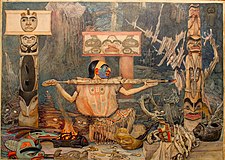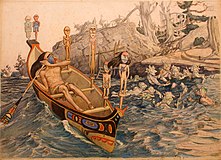m genauer |
Randy Kryn (talk | contribs) →Plot: uppercase per proper name, Wikipedia style, and direct link (Earth) |
||
| (11 intermediate revisions by 10 users not shown) | |||
| Line 1: | Line 1: | ||
{{Short description|1916 novel by Frederick Judd Waugh}} |
|||
[[ |
[[File:Waugh Clan of Munes cover art 02.jpg|thumb|Original cover (1916)]] |
||
'''The Clan of Munes''' ist ein [[Fantasy]]-[[Roman]] und [[Kinder- und Jugendliteratur|Kinderbuch]] des [[Vereinigte Staaten|US-amerikanischen]] Malers und Illustrators [[Frederick Judd Waugh]]. Das selbstbebilderte Buch erschien 1916 und blieb das einzige schriftstellerische Werk des bekannten [[Marinemalerei|Marinemalers]]. |
|||
'''The Clan of Munes''' is a [[fantasy]] [[novel]] and [[Children's literature|children's book]] by [[United States|American]] painter and illustrator [[Frederick Judd Waugh]]. The self-illustrated novel was published by [[Charles Scribner's Sons]] in 1916 and remained the only book published by the popular [[Marine art|marine painter]]. |
|||
== |
== Plot == |
||
The story is told from the perspective of [[First-person narrative|first-person narrator]]. |
|||
Die Geschichte wird aus der Perspektive eines [[Ich-Erzähler]]s geschildert. |
|||
Beneath the [[Earth's crust]] a big bubble of gas explodes where the sea is 50 [[fathoms]] deep. Following the impact of the explosion, rocks and sand are catapulted to the surface. Birds drop seeds onto them that grow into huge [[spruce]] trees. One day an [[Indigenous peoples of the Americas|Indian]] wizard from the north, who is striving for being a mighty magician in style of the [[Tlingit]] or [[Haida people|Haida]], arrives. He collects some of the spruce woods lying around, builds characters out of them and brings them to life by showering them with a magic [[potion]] and burying them in the deep snow. Bit by bit he gives his so-called ''munes'' characteristics to his taste and makes them immune to fire. Soon, however, his spells reach their limits and he has to recognize that his creation develops a life of its own. After a phase of [[lethargy]] the wizard gets rid of an [[usurper]] and regains control over his tribe of munes. He creates cows, whose milk the munes feast on until they get fat, and a monstrous ant that gnaws the fat off their bodies again. After all, the wood people have enough of the wizard and his magic, destroy his house and his possessions and chase him away in order to finally be able to lead a self-determined life. |
|||
Unter der [[Erdkruste]] explodiert eine riesige, mit Gas gefüllte Blase, dort wo die Meerestiefe 50 [[Nautischer Faden|nautische Fäden]] beträgt. Durch die Wucht der Explosion gelangen Fels und Sand an die Oberfläche. Vögel lassen darin Samen fallen, die im Seegras aufgehen und zu gewaltigen [[Fichten]]wäldern heranwachsen. Eines Tages kommt ein indianischer Zauberer aus dem Norden, der danach strebt, ein mächtiger Magier im Stil der [[Tlingit (Volk)|Tlingit]] oder [[Haida (Volk)|Haida]] zu sein. Er sammelt einige umherliegende Fichtenhölzer auf, setzt sie zu Figuren zusammen und erweckt sie zum Leben, indem er sie mit einem Zaubertrank übergießt und im Tiefschnee vergräbt. Nach und nach verpasst er den so geschaffenen ''Munes'' Eigenschaften nach seinem Geschmack und macht sie etwa immun gegen Feuer. Bald stoßen seine Zauber jedoch an ihre Grenzen und er muss erkennen, dass seine Schöpfung ein Eigenleben entwickelt. Nach einer Phase der [[Lethargie]] entledigt er sich eines [[Usurpation|Usurpators]] und gewinnt die Kontrolle über den Stamm zurück. Er erschafft Kühe, an deren Milch sich die Munes laben, bis sie fett werden, und eine monströse Ameise, die ihnen das Fett wieder vom Leib nagt. Schließlich haben die Holzmenschen aber genug vom Zauberer und seiner Magie, zerstören sein Haus und seine Besitztümer und verjagen ihn, um endlich ein selbstbestimmtes Leben führen zu können. |
|||
== |
== Illustrations == |
||
<gallery class="center" widths="230" heights="160" perrow="4" caption=" |
<gallery class="center" widths="230" heights="160" perrow="4" caption="''The Clan of Munes'' illustrations (1914–1916)"> |
||
Waugh Clan of Munes 06.jpg| |
Waugh Clan of Munes 06.jpg|The wizard prepares the summoning of the munes |
||
Waugh Clan of the Munes 01.jpg|Munes |
Waugh Clan of the Munes 01.jpg|Munes with a dog |
||
Waugh Clan of Munes 07.jpg| |
Waugh Clan of Munes 07.jpg|The wizard overhears a group of munes from a canoe |
||
Waugh Clan of Munes 08.jpg| |
Waugh Clan of Munes 08.jpg|The munes chase away the wizard and his [[totem]]s |
||
</gallery> |
</gallery> |
||
== |
== Background == |
||
Frederick Judd Waugh |
Frederick Judd Waugh first visited the artist colony [[Monhegan, Maine]], in 1911. In the following years he spent much time on the little island twelve miles from the mainland as he took a break from painting and [[sketch (drawing)|sketching]]. On the rocky coast he collected gnarled roots and branches of spruce trees which he transformed into the main characters of a [[fairytale]] for his family. Within four years the artist created a story with illustrations inspired by the indigenous people [[Haida people|Haida]] and [[Tlingit]] in the [[Pacific Northwest]].<ref>{{Cite book|url=https://www.worldcat.org/oclc/8244309|title=The clan of munes|publisher=[[WorldCat]]|oclc=8244309 |accessdate=13 November 2020}}</ref> The full novel was published in November 1916 by [[Charles Scribner's Sons]]. Although it received positive reviews the 56-pages book remained a slow seller and Waugh bought back the remaining copies from the publisher.<ref name="ulrich">{{Cite web|url=https://www.wichita.edu/museums/ulrich/Art/Exhibitions/TheClanofMunes.php|title=The Clan of Munes: Frederick J. Waugh|publisher=Ulrich Museum of Art|date=January 2014|accessdate=26 December 2019}}</ref><ref>{{Cite web|url=https://grapefruitmoongallery.com/38461|title=The Clan of Munes|date=9 March 2016 |publisher=Grapefruit Moon Gallery|accessdate=13 November 2020}}</ref> As a result, only few of them are in circulation today and are offered on the internet at high prices. |
||
All 28 original drawings are in the possession of the Edwin A. Ulrich Museum of Art at [[Wichita State University]]. They were last exhibited at the beginning of 2014 together with two hand-crafted munes.<ref name="ulrich" /> |
|||
{{Commons category}} |
|||
== Weblinks == |
|||
{{Commonscat}} |
|||
== |
== References == |
||
<references /> |
<references /> |
||
{{Portal |Children's literature}} |
|||
| ⚫ | |||
[[Kategorie:Literarisches Werk]] |
|||
| ⚫ | |||
[[Kategorie:Literatur (20. Jahrhundert)]] |
|||
[[Category:1916 American novels]] |
|||
[[Kategorie:Literatur (Englisch)]] |
|||
[[Category:1916 fantasy novels]] |
|||
[[Kategorie:Literatur (Vereinigte Staaten)]] |
|||
[[Category:American fantasy novels]] |
|||
[[Kategorie:Kinderliteratur]] |
|||
[[Category:Children's fantasy novels]] |
|||
[[Kategorie:Fantasyliteratur]] |
|||
[[Kategorie:Märchen]] |
|||
[[Kategorie:Roman, Epik]] |
|||
Latest revision as of 15:33, 23 October 2023

The Clan of Munes is a fantasy novel and children's book by American painter and illustrator Frederick Judd Waugh. The self-illustrated novel was published by Charles Scribner's Sons in 1916 and remained the only book published by the popular marine painter.
Plot[edit]
The story is told from the perspective of first-person narrator.
Beneath the Earth's crust a big bubble of gas explodes where the sea is 50 fathoms deep. Following the impact of the explosion, rocks and sand are catapulted to the surface. Birds drop seeds onto them that grow into huge spruce trees. One day an Indian wizard from the north, who is striving for being a mighty magician in style of the Tlingit or Haida, arrives. He collects some of the spruce woods lying around, builds characters out of them and brings them to life by showering them with a magic potion and burying them in the deep snow. Bit by bit he gives his so-called munes characteristics to his taste and makes them immune to fire. Soon, however, his spells reach their limits and he has to recognize that his creation develops a life of its own. After a phase of lethargy the wizard gets rid of an usurper and regains control over his tribe of munes. He creates cows, whose milk the munes feast on until they get fat, and a monstrous ant that gnaws the fat off their bodies again. After all, the wood people have enough of the wizard and his magic, destroy his house and his possessions and chase him away in order to finally be able to lead a self-determined life.
Illustrations[edit]
- The Clan of Munes illustrations (1914–1916)
-
The wizard prepares the summoning of the munes
-
Munes with a dog
-
The wizard overhears a group of munes from a canoe
-
The munes chase away the wizard and his totems
Background[edit]
Frederick Judd Waugh first visited the artist colony Monhegan, Maine, in 1911. In the following years he spent much time on the little island twelve miles from the mainland as he took a break from painting and sketching. On the rocky coast he collected gnarled roots and branches of spruce trees which he transformed into the main characters of a fairytale for his family. Within four years the artist created a story with illustrations inspired by the indigenous people Haida and Tlingit in the Pacific Northwest.[1] The full novel was published in November 1916 by Charles Scribner's Sons. Although it received positive reviews the 56-pages book remained a slow seller and Waugh bought back the remaining copies from the publisher.[2][3] As a result, only few of them are in circulation today and are offered on the internet at high prices.
All 28 original drawings are in the possession of the Edwin A. Ulrich Museum of Art at Wichita State University. They were last exhibited at the beginning of 2014 together with two hand-crafted munes.[2]
References[edit]
- ^ The clan of munes. WorldCat. OCLC 8244309. Retrieved 13 November 2020.
- ^ a b "The Clan of Munes: Frederick J. Waugh". Ulrich Museum of Art. January 2014. Retrieved 26 December 2019.
- ^ "The Clan of Munes". Grapefruit Moon Gallery. 9 March 2016. Retrieved 13 November 2020.



